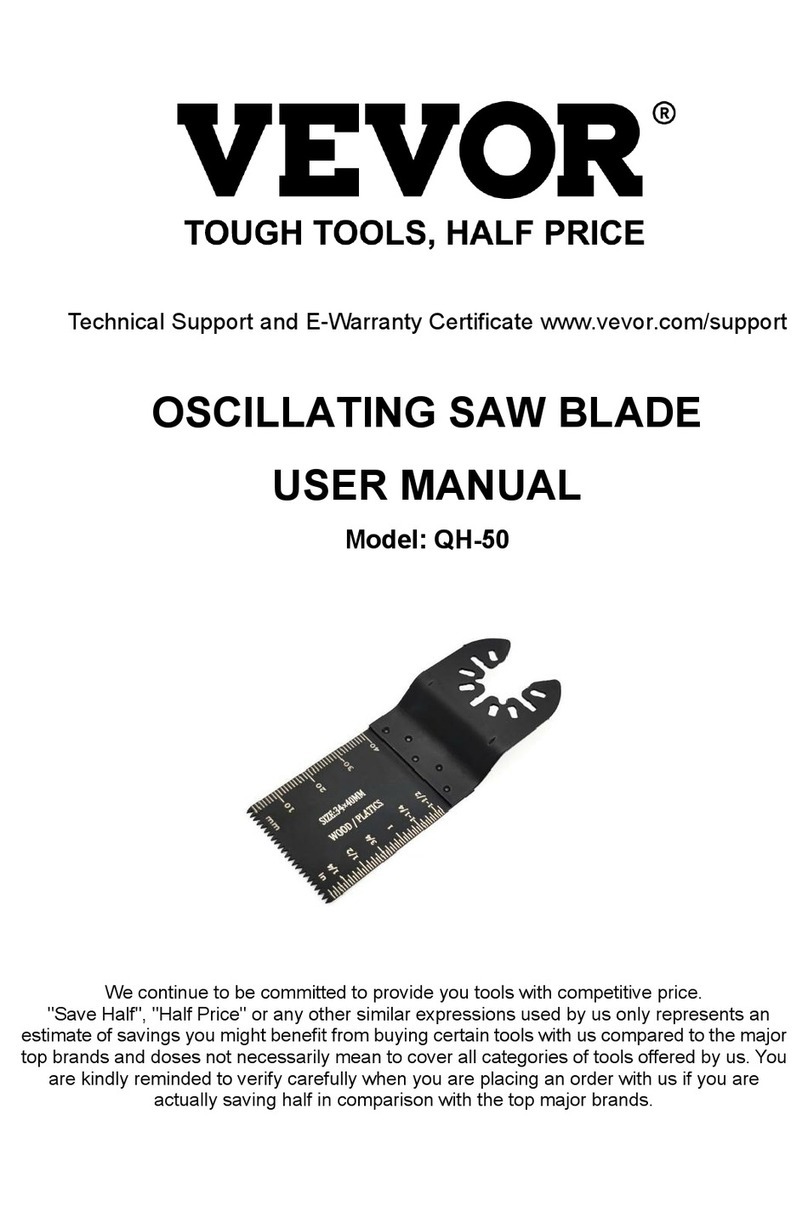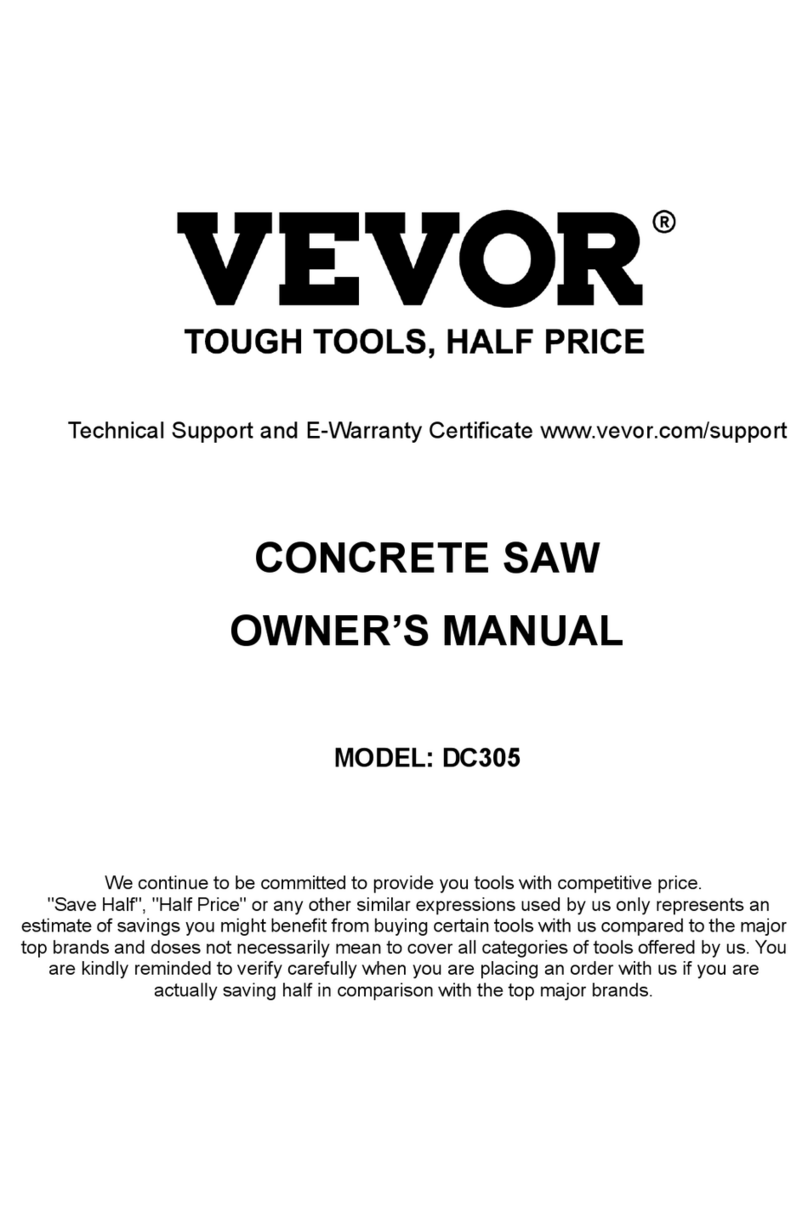VEVOR TC180II User manual

Technical Support and E-Warranty Certificate www.vevor.com/support
WET TILE SAW
MODEL:TC180II
We continue to be committed to provide you tools with competitive price.
"Save Half", "Half Price" or any other similar expressions used by us only represents an
estimate of savings you might benefit from buying certain tools with us compared to the major
top brands and doses not necessarily mean to cover all categories of tools offered by us. You
are kindly reminded to verify carefully when you are placing an order with us if you are
actually saving half in comparison with the top major brands.

MODEL:TC180II
Have product questions? Need technical support? Please feel free to
contact us:
CustomerService@vevor.com
NEED HELP? CONTACT US!
This is the original instruction, please read all manual instructions
carefully before operating. VEVOR reserves a clear interpretation of our
user manual. The appearance of the product shall be subject to the
product you received. Please forgive us that we won't inform you again if
there are any technology or software updates on our product.
WET TILE SAW

Symbol description
Warning - To reduce the risk of injury, user must read
instructions manual carefully.
This symbol, placed before a safety comment, indicates a
kind of precaution, warning, or danger. Ignoring this warning
may lead to an accident. To reduce the risk of injury, fire, or
electrocution, please always follow the recommendation
shown below.
Warning- Be sure to wear eye protectors when using this
product.
FCC STATEMENT
This device complies with Part 15 of the FCC Rules.
Operation is subject to the following two conditions:(1)This
device may not cause harmful interference, and (2)this
device must accept any interference received, including
interference that may cause undesired operation

1
EN
CONTENTS
1. INTENDED USE FOR THE WET TILE SAW
2. SAFETY INSTRUCTIONS
3. DESCRIPTION
4. TECHNICAL DATA
5. BEFORE STARTING THE EQUIPMENT
6. ASSEMBLY
7. OPERATION
8. MAINTENANCE
9. TROUBLE SHOOTING
10. DISPOSAL AND RECYCLING 11. EXPLODED VIEW
12. PART LIST
13. GUARANTEE

2
EN
1. INTENDED USE FOR THE WET TILE SAW
This machine is designed for sawing cutting brick, stone, oor- and wall tiles, etc. The machine is not for
the professsional version of use.
Machining of other materials is not permitted and may be carried out in specic cases only after
consulting with the manufacturer.
No metal work pieces may be machined.
The proper use also includes compliance with the operating and maintenance instructions given in this
manual.
The machine must be operated only by persons familiar with its operation, maintenance and repair and
who are familiar with its hazards.
The required minimum age must be observed.
The machine must only be used in a technically perfect condition when working on the machine, all
safety mechanisms and covers must be mounted.
In addition to the safety requirements contained in this operating instructions and your country’s
applicable regulations, you should observe the generally recognized technical rules concerning the
operation of machines.
Any other use exceeds authorization. In the event of unauthorized use of the machine, the
manufacturer renounces all liability and the responsibility is transferred exclusively to the operator.
2. SAFETY INSTRUCTIONS
2.1 GENERAL SAFETY RULES
Keep all safety instructions and information for future reference!
The term "power tool" in the warnings refers to your mains-operated (corded) power tool or
battery-operated (cordless) power tool.
1. Work area safety
a) Keep work area clean and well lit. Cluttered or dark areas invite accidents.
b) Do not operate power tools in explosive atmospheres, such as in the presence of ammable
liquids, gases or dust. Power tools create sparks which may ignite the dust or fumes.
c) Keep children and bystanders away while operating a power tool. Distractions can cause you to
lose control.
2. Electrical safety
a) Power tool plugs must match the outlet. Never modify the plug in any way. Do not use any
adapter plugs with earthed (grounded) power tools. Unmodied plugs and matching outlets will
reduce risk of electric shock.
b) Avoid body contact with earthed or grounded surfaces, such as pipes, radiators, ranges and
refrigerators. There is an increased risk of electric shock if your body is earthed or grounded.
c) Do not expose power tools to rain or wet conditions. Water entering a power tool will increase the
risk of electric shock.
d) Do not abuse the cord. Never use the cord for carrying, pulling or unplugging the power tool.
Keep cord away from heat, oil, sharp edges or moving parts. Damaged or entangled cords
increase the risk of electric shock.
WARNING ! Read all safety warnings, instructions,
illustrations and specications provided with this power tool.
Failure to follow all instructions listed below may result in electric
shock, re and/or serious injury.

3
EN
e) When operating a power tool outdoors, use an extension cord suitable for outdoor use. Use of
a cord suitable for outdoor use reduces the risk of electric shock.
f) If operating a power tool in a damp location is unavoidable, use a residual current device (RCD)
protected supply. Use of an RCD reduces the risk of electric shock.
3. Personal safety
a) Stay alert, watch what you are doing and use common sense when operating a power tool. Do
not use a power tool while you are tired or under the inuence of drugs, alcohol or medication.
A moment of inattention while operating power tools may result in serious personal injury.
b) Use personal protective equipment. Always wear eye protection. Protective equipment such as
dust mask, non-skid safety shoes, hard hat, or hearing protection used for appropriate conditions will
reduce personal injuries.
c) Prevent unintentional starting. Ensure the switch is in the o-position before connecting to
power source and/or battery pack, picking up or carrying the tool. Carrying power tools with
your nger on the switch or energising power tools that have the switch on invites accidents.
d) Remove any adjusting key or wrench before turning the power tool on. A wrench or a key left
attached to a rotating part of the device may result in personal injury.
e) Do not overreach. Keep proper footing and balance at all times. This enables better control of
the power tool in unexpected situations.
f) Dress properly. Do not wear loose clothing or jewellery. Keep your hair and clothing away
from moving parts. Loose clothes, jewellery or long hair can be caught in moving parts.
g) If devices are provided for the connection of dust extraction and collection facilities, ensure
these are connected and properly used. Use of dust extraction can reduce dustrelated hazards.
h) Do not let familiarity gained from frequent use of tools allow you to become complacent and
ignore tool safety principles. A careless action can cause severe injury within a fraction of a second.
4. Power tool use and care
a) Do not force the power tool. Use the correct power tool for your application. The correct power
tool will do the job better and safer at the rate for which it was designed.
b) Do not use the power tool if the switch does not turn it on and o. Any power tool that cannot
be controlled with the switch is dangerous and must be repaired.
c) Disconnect the plug from the power source and/or remove the battery pack, if detachable,
from the power tool before making any adjustments, changing accessories, or storing power
tools. Such preventive safety measures reduce the risk of starting the power tool accidentally.
d) Store idle power tools out of the reach of children. Do not allow persons unfamiliar with the
power tool or these instructions to operate the power tool. Power tools are dangerous in the
hands of untrained users.
e) Maintain power tools and accessories with care. Check for misalignment or binding of moving
parts, breakage of parts and any other condition that may aect the power tool’s operation. If
damaged, have the power tool repaired before use. Many accidents are caused by poorly
maintained power tools.
f) Keep cutting tools sharp and clean. Properly maintained cutting tools with sharp cutting edges are
less likely to bind and are easier to control.
g) Use the power tool, accessories, tool bits etc. in accordance with these instructions. Take into
account the working conditions and the work to be performed. Use of the power tool for
operations dierent from those intended could result in a hazardous situation.
h) Keep handles and grasping surfaces dry, clean and free from oil and grease. Slippery handles
and grasping surfaces do not allow for safe handling and control of the tool in unexpected situations.
5. Service
a) Have your power tool serviced by a qualied repair person using only identical replacement
parts. This will ensure that the safety of the power tool is maintained.

EN
4
2.2 ADDITIONAL SAFETY INSTRUCTIONS
• Ensure that the directional arrow on the cutting disc imatches the directional arrow on the machine
(the motor’s rotating direction).
• No other people should be in the immediate vicinity of the machine when you are using it. Bystanders
must be kept at an appropriate safe distance.
• Never run the power cord over the machine table!
• Never cut “free hand”. The workpiece must always be stable and lie at on the machine table. The
workpiece must always be pressed tightly up against the fence.
• Never cut workpieces which are so small that they cannot be safely pressed against the fence and
could be twisted.
• Never cut workpieces which are so small that they can’t be held at a safe distance from the cutting
disc.
• Always cut only one work piece. Never cut several workpieces at the same time. Workpieces should
never be laid behind one another or on top of one another. There is a danger of jamming and being
ung away.
• Make sure that the workpiece cannot slip or get jammed in the cutting disc while it is being cut.
• Remove cut and jammed work pieces only when plug disconnected, motor is turned off and the
machine is at a complete standstill.
• Clean the work surface and the workpiece after each cut. Switch the machine off to clean it. There
should be no foreign bodies on the workpiece or the machine table. Cut tile parts can get caught in
the cutting disc and ung around.
• Never reomove any cut parts, if the machine is switched on. Risk of cuts!
• Cut workpieces can have sharp cutting edges. Careful, you may cut yourself!
• Unplug the machine, if you are leaving it unattended.
• Only use clean water without any additives as coolant.
• Never expose the machine to the elements for an unnecessarily long period of time.
• If the replacement of the supply cord is necessary, this has to be done by the manufacturer or his
agent in order to avoid a safety hazard.
• Keep water clear of the electrical parts of the tool and away from persons in the working area.
• Never use a cutting blade rated with a blade speed lower than the machine.
RESIDUAL RISKS
Even if you operate this power tool according to the instructions residual risks will always remain.
The following risks may arise dut to the design and constrction of this power tool:
• Damage to health resulting from hand-arm vibrations if the power tool is used for a long period of
time or is not used or maintained properly.
• Injuries and material damage caused by loose tool attachments which, because of sudden damage,
wear or improper tting, are unexpectedly thrown out of/from the power tool.
WARNING ! This power tool generates an electromagnetic eld
during operation. This eld may impair active or passive medical
implants under certain circumstances.
To reduce the risk of serious or fatal injuries we recommend that
people with medical implants consult their doctor and the
manufacturer of the medical implant before operating the power
tool.

5
EN
3. DESCRIPTION
1. Upper blade guard
2. Diamond blade
3. Tiltable table (xed with 2
locking knobs and 2 washers)
4. Lower blade cover
5. Water tank
6. Table adjustment knob
7. ON – OFF switch
8. Parallel guide locking knobs
9. Parallel guide
10. Diagonal cut guiding device
• Open the packaging and take out the equipment with care.
• Remove the packaging material and any packaging and/or transportation braces (if present).
• Check to see if all the items are supplied.
• Inspect the equipment and accessories for damage in transit.
• If possible, keep the packaging until the end of the guarantee period.
For detail items supplied, please see provided "Assembly instruction".
WARNING ! Read all the safety information and instructions.
Failure to adhere to the safety information and instructions set
out below may result in electric shock, re and/or serious injury.
Keep all the safety information and instructions in a safe place for
future use.
WARNING ! The equipment and packaging material are not toys.
Do not let children play with plastic bags, plastic sheets and small
parts. There is a risk of choking and suocating!
Any modication which could lead to a change in the original characteristics of the machine, for
example, the rotation speed or the maximum diameter of the cutting wheel, may be carried out only by
the manufacturer of the machine who conrm that the machine is still in conformity with safety
regulations.
1
2
3
4
5
7
8
9
6
10

EN
6
Sound and vibration
The noise emission values were measured in accordance with EN 62841-1:2015.
Note: Recommendation for the operator to wear hearing protection.
that the declared noise emission value(s) have been measured in accordance with a standard test
method and may be used for comparing one tool with another;
that the declared noise emission value(s) may also be used in a preliminary assessment of exposure.
the noise emissions during actual use of the power tool can dier from the declared values depending
on the ways in which the tool is used especially what kind of workpiece is processed;
need to identify safety measures to protect the operator that are based on an estimation of exposure in
the actual conditions of use (taking account of all parts of the operating cycle such as the times when
the tool is switched o and when it is running idle in addition to the trigger time).
The machine is designed for operating in S1 mode (continuous operation) under 450W power and S2
mode (short-term operation) under 550W power. S2 mode means that you can operate the machine for
an uninterrupted period of 10 minutes at most with a nominal load after this period of time has
elapsed, you must switch o the appliance and allow it to cool down completely. Afterwards, it can be
used again for a maximum of 10 minutes.
4. TECHNICAL DATA
Voltage
Amperage
No load speed
Machine Table
Cutting blade diameter
Blade bore diameter
120V ~ ,6
Maximum Cutting Depth at 90°
Maximum Cutting Depth at 45°
Tilting range of blade
0Hz
4A
3500RMP
ø22.
360 x 330mm
ø180 mm
2 mm
1-1/4 in.
3/4 in.
0°- 45° left
5. BEFORE STARTING THE EQUIPMENT
• The machine must be set up to a stand or work bench or similar. Before setting up the machine,
choose a stable surface, that is free of obstacles (except materials to be cut) and adequately lit.
• All covers and safety devices must be properly tted before the equipment is switched on.
• The cutting wheel must rotate smoothly.
• Check that the voltage on the rating plate is the same as your supply voltage before you connect the
equipment to the power supply.
• Always stand on the front of the machine when operating.
LpA sound pressure level
LWA sound power level
Uncertainty K
76 dB(A)
89 dB(A)
KpA=3 dB(A); KWA=3 dB(A)

EN
7
MOUNTING THE CUTTING BLADE
• Attach the staight wrench to the hex nut.
• Use angle wrench to lock the motor shaft.
• Loosen the hex nut, remove it and outer ange.
• Place one new cutting disc on inner ange with arrows on cutting disc going in the counterclockwise
direction.
• Attach the outer ange.
• Screw hex nut onto motor shaft clockwise.
• Attach the straight wrench to the hex nut.
• Use angle wrench to lock the motor shaft.
• Tighten hex nut clockwise using straight wrench.
• Screw the lower blade cover into place and attach the water tank.
MOUNTING THE UPPER BLADE GUARD BRACKET
• Clean all rust protected surfaces with a mild solvent.
• Loosen two screws with hex wrench (included) then attach the upper blade guard bracket using two
screws.
MOUNTING THE UPPER BLADE GUARD
• Attach the upper blade guard to the upper blade guard bracket with 1 plastic knob and lock nut. The
metal shaft which has been premounted already must be located above the upper blade guard and
thus serves as a limit stop for the protective hood upper blade guard.
ADJUSTING THE UPPER BLADE GUARD
• The blade guard must always be used.
• The saw guard must be lowered to the work piece to minimise the amount of exposed blade.
• Ensure that upper blade can move freely and that it cannot touch the cutting disc when in use.
MOUNTING THE PARALLEL GUIDE
Setup adjustments of the cutting blade shall never be performed when the machine is running. Set the
parallel guide at the both ends of the table, place it in the cutting position, attach the internal clamping
plates in place (note that watch out for internal clamping plates bending).) and tighten the parallel
guide locking knobs in the front and back.
FILL THE WATER TANK
Fill the water tank up to the max. level mark.
WARNING ! The upper blade guard bracket must always be
aligned to the cutting blade so that the upper blade guard
bracket does not Interfere with material being cut.
WARNING ! Do not over-tighten the plastic knob. The upper
blade guard must be free.
WARNING ! Pull out the power plug before assembling, adjusting
and changing the cutting disc.
6. ASSEMBLY

EN
8
7. OPERATION
ON/OFF SWITCH
WARNING! Before starting:
• Ensure that there are no visible defects.
• Ensure that there is nothing in the work area that may hamper the work to be performed.
• Ensure that there is sufficient cooling water.
• Ensure that the guard is correctly mounted.
• Ensure that no one other than the operator is in the working area.
• For safety reasons replace the tool if it is found to be damaged in any way.
• To switch on, press the “I” on the on/off switch.
• Before you begin cutting, wait until the cutting wheel has reached maximum speed and wait for the
cutting disc to get wet.
• To switch off, press the “O” on the on/off switch.
• Pre-cut 2cm at the end side for better cutting surface.
TO MAKE A CROSS CUT
Cross cuts are straight 90° cuts. The material is fed into the cut at a 90° angle to the cutting disc.
• Using a marker or grease pencil, mark the area to be cut on material.
• Adjust parallel guide to desired position and push down the locking lever to secure it.
• Place the material on the table and rmly against the parallel guide.
• Make sure the material is clear of the cutting disc before turning on the saw.
• Turn the on/off switch to the on position.
• Let the cutting disc get up to full speed and wait for the cutting disc to get wet before moving the
material into the cutting disc.
• Hold the material rmly against the parallel guide and feed the material into the cutting disc.
• When the cut is made, turn the saw off. Wait for the cutting disc to come to a complete stop before
removing any part of the material.
TO MAKE A 45° DIAGONAL CUT
45° diagonal cuts are also referred to as “TO MAKE A CROSS CUT”.
• Using a marker or grease pencil, mark the area to be cut on material.
• Set the parallel guide to desired width, and tighten the locking knobs to secure in place.
• Push the straight edge of the diagonal cut guiding device against the parallel guide.
• Make sure the material is clear of the cutting disc before turning on the saw.
• Turn the on/off switch to the on position.
• Let the cutting disc build up to full speed and wait for the cutting disc to get wet before moving the
material into the cutting disc.
• Hold the material rmly against the diagonal cut guide device and slide diagonal cut guide device
along parallel guide. Feed the material into the cutting disc.
• When the cut is made, turn the saw off. Wait for the cutting disc to come to a complete stop before
removing any part of the material.
TO MAKE A BEVEL CUT
Beveled 0°-45° cuts can be made tilting the table.
• Using a marker or grease pencil, mark the area to be cut on material.
• Loosen two locking knobs (one on the front and one on the back).
• Tilt the table to the desired angle, use the angle scale, and tighten two locking knobs.
• Set the parallel guide to desired width, and tighten the locking knobs to secure in place.
• Turn the on/off switch to the on position.
• Let the cutting disc get up to full speed and wait for the cutting disc to get wet before moving the
material into the cutting disc.
• Hold the material rmly against the 45° vertical fence and feed the material into the cutting disc.
• When the cut is made, turn the saw off. Wait for the cutting disc to come to a complete stop before
removing any part of the material.
• Tilt the table to 0° angle when nish the cutting.

EN
9
WARNING! Remove the plug from the power socket before
carrying out any adjustment, servicing or maintenance.
8. MAINTENANCE
CUTTING BLADE
The servicing of cutting blades should only be performed by a trained person.
Defective safety devices must be replaced immediately.
Check cutting blades regularly for faults. Replace a defective cutting blades immediately.
CLEANING
• Always allow the appliance to cool down after use.
• Remove all of the water from the tank.
• Clean the machine with a damp cloth and some soap. Use brushes or scrubbers to clean places that
are hard to reach and stubborn residue. Don’t use any harsh cleaning agents or solvents. These could
adversely aect the plastic and metal parts of the tool.
• Keep the motor’s vent openings free of deposits.
REPAIR
Damage should be repaired by qualied experts, only.
The equipment is supplied in packaging to prevent it from being damaged in transit. The raw materials
in this packaging can be reused or recycled.
The equipment and its accessories are made of various types of material, such as metal and plastic.
Defective components must be disposed of as special waste. Ask your dealer or your local council.
STORAGE
• Allow the cleaned machine to dry completely.
• Store the appliance and its accessories in a dark, dry, frost-free place. Always store the tool in a place
that is inaccessible to children. The ideal storage temperature is between 10 and 30°C.
• Always store the machine in its original packaging, if possible.
TRANSPORT
• Dismantle any components that protrude from the product.
• Use the original packaging to ship whenever possible.
• Protect the product from any heavy impact or strong vibrations which may occur during transpotation
in vehicles.
• Secure the product to prevent it from slipping or falling over.
• Never lift the machine on it’s guard.
TO CHANGE WATER
• Unplug tile saw.
• Pull out the water tank and empty into a bucket, do not allow water to splash onto ground or around
machine.
• Discard waste water in accordance with local regulations.
CHANGING THE CUTTING BLADE
Remove the water tank, then undo the two screws holding the lower blade cover and remove the
blade cover so that the blade is accessible.
Remove the blade nut and the outer ange washer from the spindle using supplied spanners (leave the
inner ange washer on the spindle)
Make sure that the blade is mounted so that it rotates in the direction indicated by the arrow on the
lower blade cover.
First place the blade onto the spindle and then the outer ange washer and nut. Tighten the nut using
the supplied spanners (Notice: The inner and outer ange washers are dierrent).
Screw the lower blade cover back into place and reattach the water tank.

EN
10
The equipment is supplied in packaging to prevent it from being damaged in transit. The raw materials
in this packaging can be reused or recycled.
The equipment and its accessories are made of various types of material, such as metal and plastic.
Defective components must be disposed of as special waste. Ask your dealer or your local council.
For EU countries only
Recycling alternative to returns
As an alternative to returning the equipment to the manufacturer, the owner of the electrical
equipment must make sure that the equipment is properly disposed of if he no longer wants to keep
the equipment.
Old equipment can be returned to a suitable collection point that will dispose of the equipment in
accordance with national recycling and waste disposal regulations.
Electric and electronic equipment can be hazardous for the environment and for human health since
they contain hazardous substances.
This does not apply to any accessories or aids without electrical components supplied with the old
equipment.
Never dispose of any electric power tools with your household refuse. To comply with
European Directive 2012/19/EU on waste electric and electronic equipment, and its
implementation in national laws, old electric power tools must be separated from other
waste and disposed of in an environment-friendly fashion, e.g. by taking them to a
recycling depot.
10. DISPOSAL AND RECYCLING
Motor doesn’t start
- No electricity, check mains.
- Defective switch, motor or cord, consult an electrician.
- Overload has reacted-Wait and start again.
Machine vibrates excessively
- Stand on uneven oor, adjust stand for even support.
- Dust on saw anges, clean saw arbor and anges.
- defective cutting blade - replace cutting blade immediately.
Cut is not accurately square
- Stops were not adjusted correctly, check with square and adjust stops.
Material binds blade when ripping
- Excessive feed rate, reduce feedrate.
Material kicked back from blade
- Parallel guide is not parallel to the cutting blade.
Cutting surfaces is bad
- Wrong cutting blade used
- Blade mounted backwards
- Resin collection on cutting blade
- cutting blade is dull
- work piece inhomogeneous
- Feed pressure too high-Do not force the work piece.
9. TROUBLE SHOOTING

EN
11
11. EXPLODED VIEW

EN
12
12. PART LIST
No. QTYDescription
Wet Tile Saw Part List
1
2
3
4
5
6
7
8
9
10
11
12
13
14
15
16
17
18
19
20
21
22
2
1
1
1
1
1
1
1
1
1
1
1
1
1
2
1
1
4
2
1
1
1
Fixed sheet
Guide
Working table
Safeguard support
Roll frame
Steel board frame
Strengthen board
Inner ange
Outer ange
Pointer
Hex wrench
Wrench
Wrench
Nut
Locking knob (A)
Upper safeguard
Locking knob
Foot
Locked knob (B)
Rubber washer
Lower protection board
Lower safeguard
No. QTYDescription
23
24
25
26
27
28
29
31
32
33
34
35
36
37
38
39
40
41
42
43
44
45
1
1
1
1
1
2
1
2
1
1
2
2
2
5
5
3
2
1
4
1
2
2
Water tank
Blade
Motor
Nut M12
Screw M5x8
Screw M4x10
Miter gauge
Scale label (A)
Hex Nut
Spring pin
Hex socket screw M4x8
Screw M6x12
Anti-loose nut M6
Spring washer ø5
Flat washer ø5
Screw M5x12
Flat washer ø4
Hex Nut M5
Big at washer ø6
Main Label
Bolt ST3.5x9.5
Ring 4
Table of contents
Other VEVOR Saw manuals
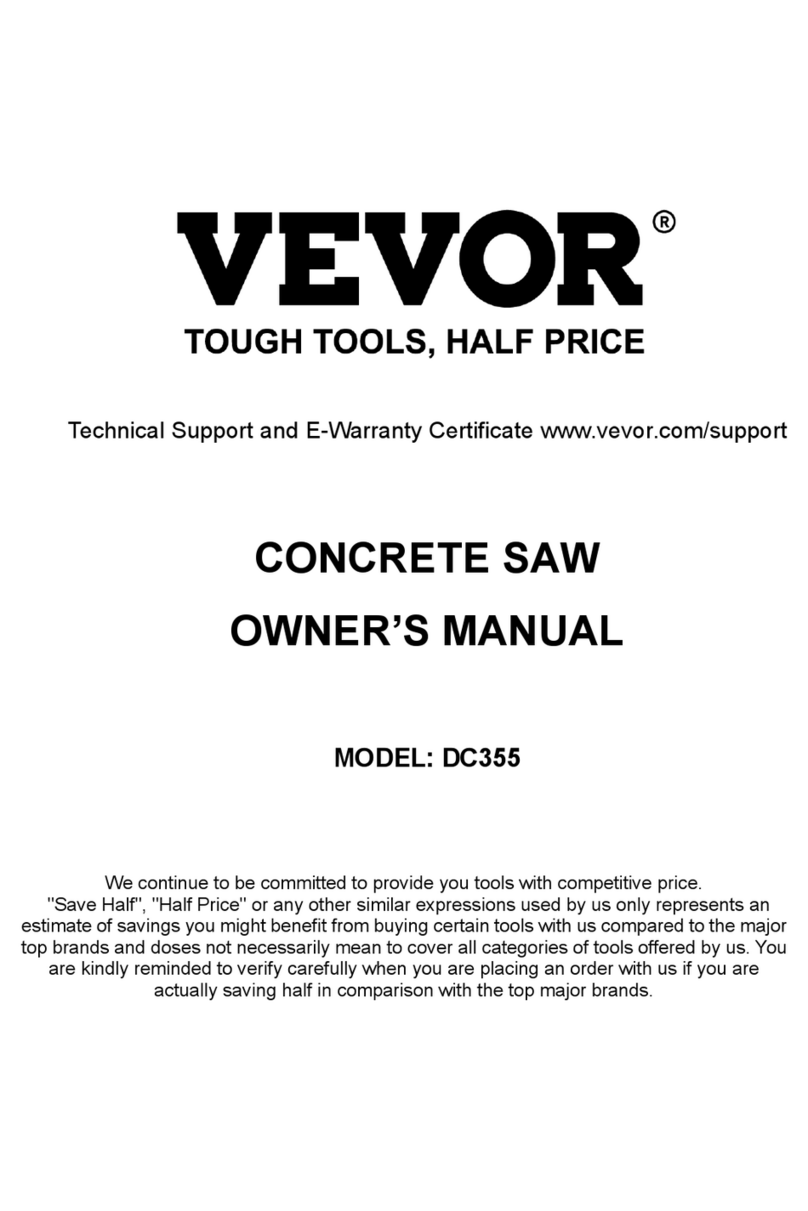
VEVOR
VEVOR DC355 User manual

VEVOR
VEVOR M1H-ZP5-254D-1 User manual

VEVOR
VEVOR M1H-ZP7-254-1 User manual
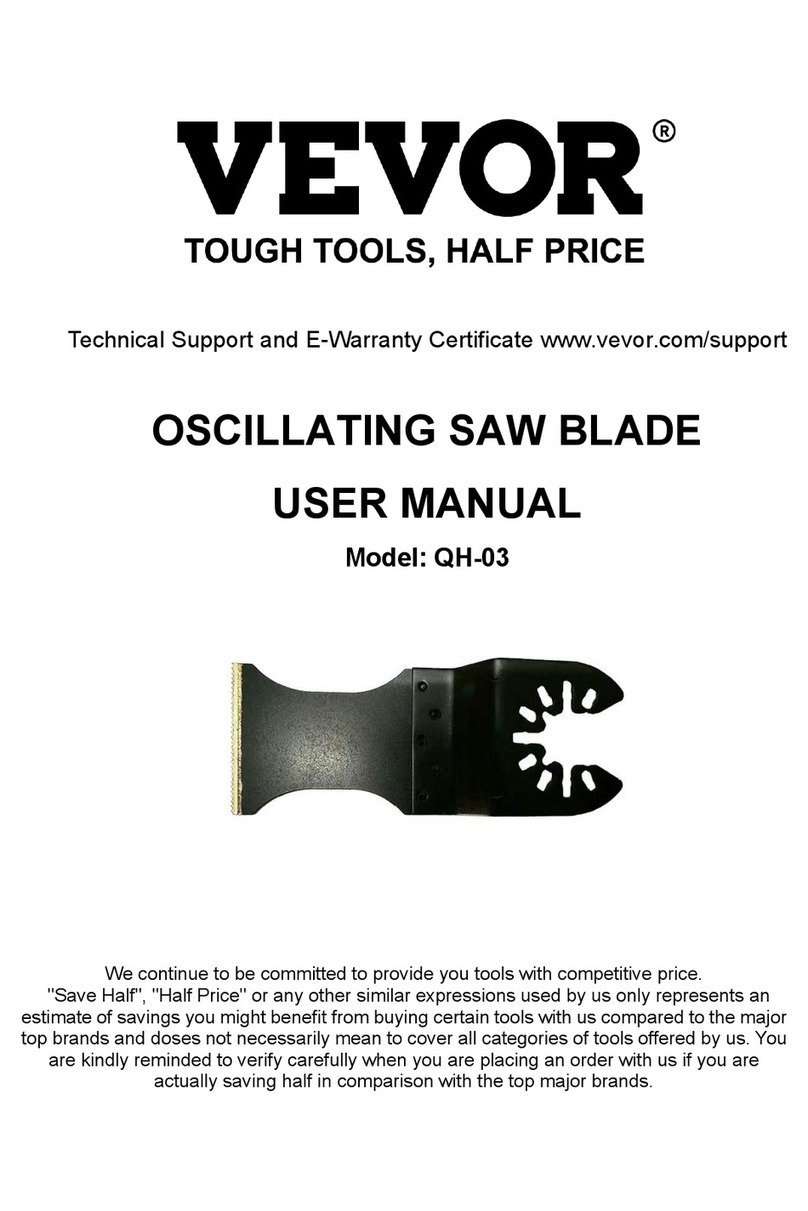
VEVOR
VEVOR QH-03 User manual
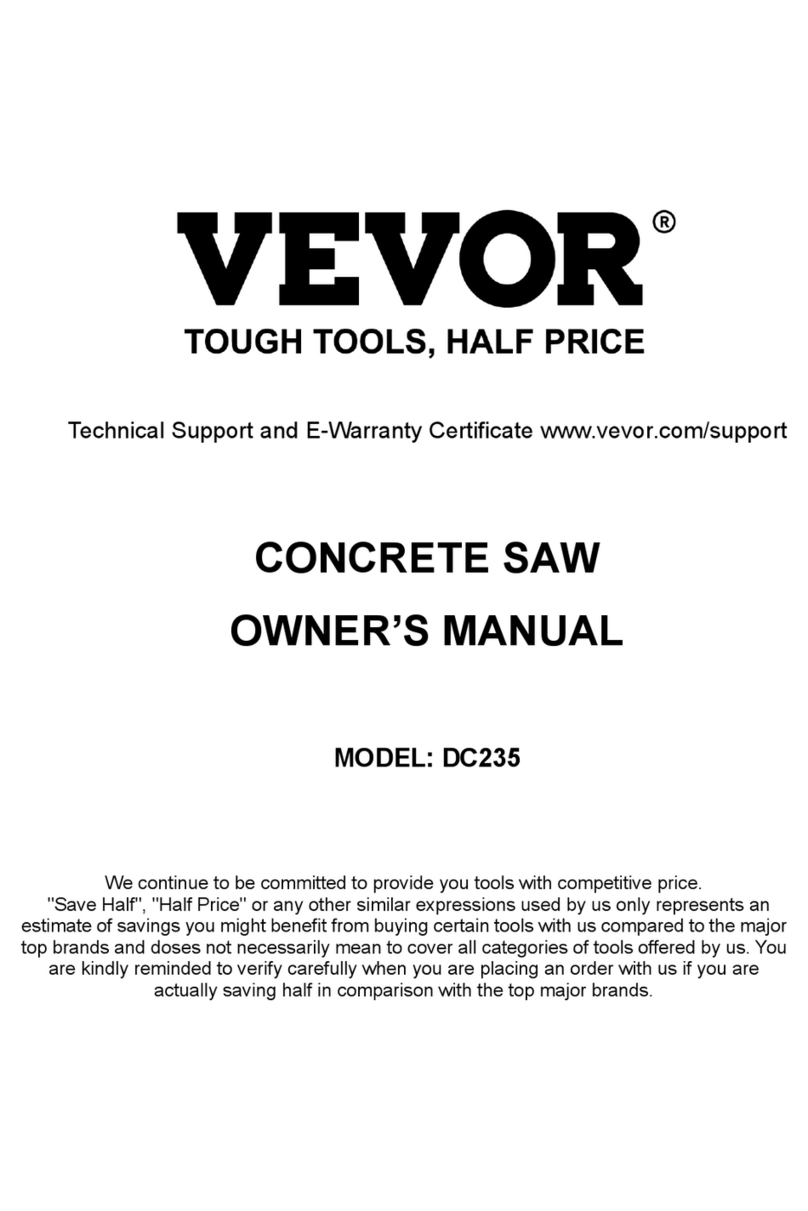
VEVOR
VEVOR DC235 User manual

VEVOR
VEVOR DC425 User manual
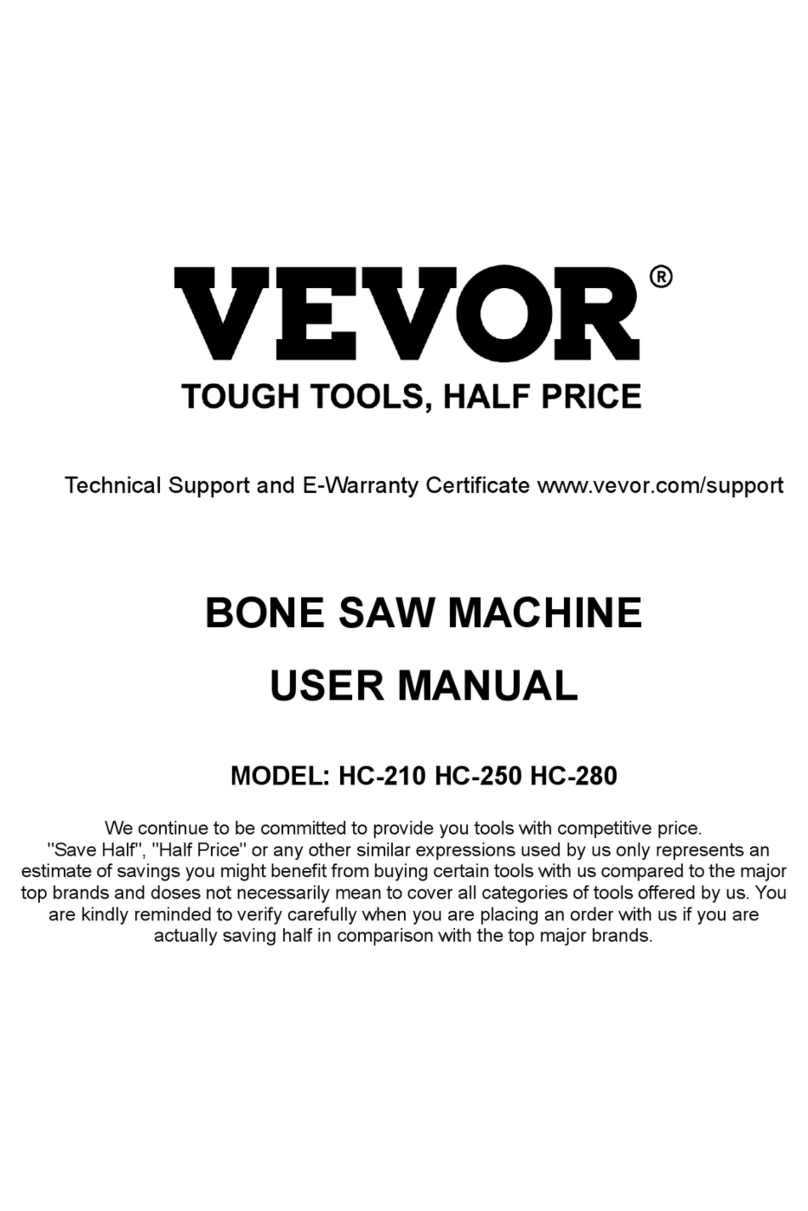
VEVOR
VEVOR HC-210 User manual
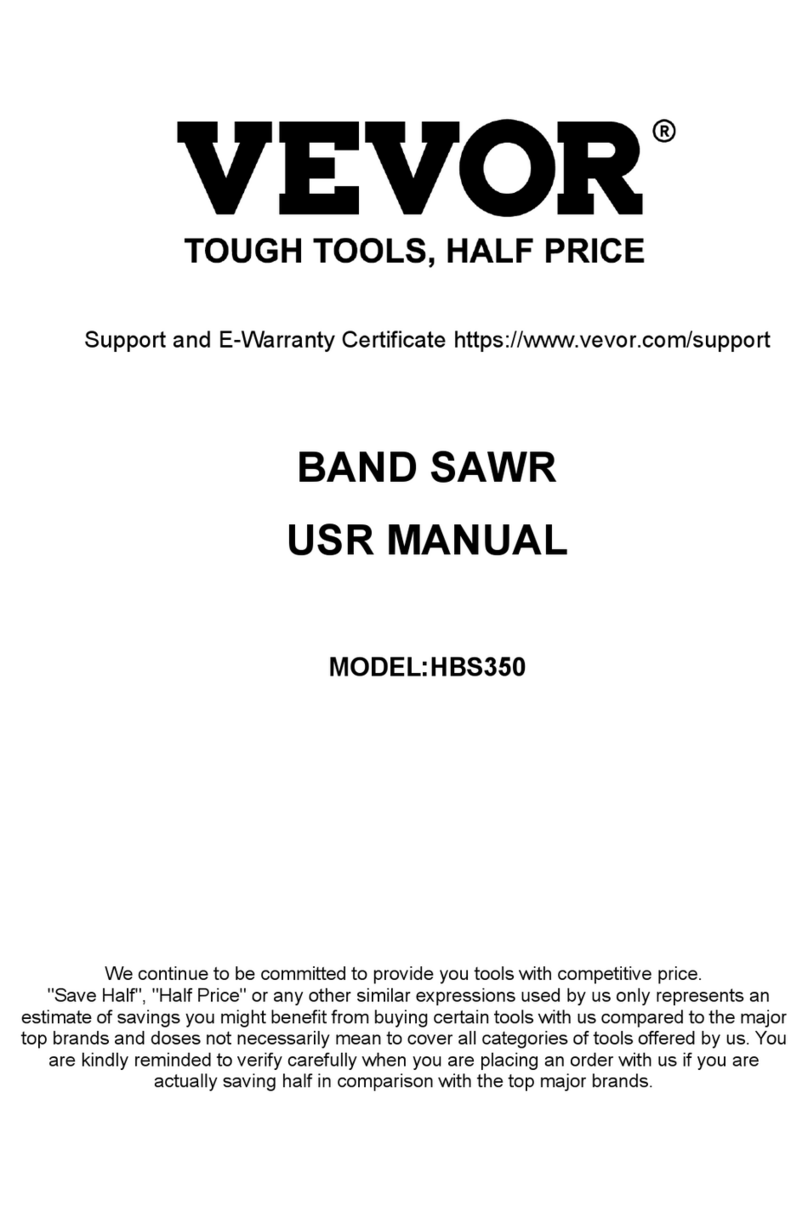
VEVOR
VEVOR HBS350 User manual
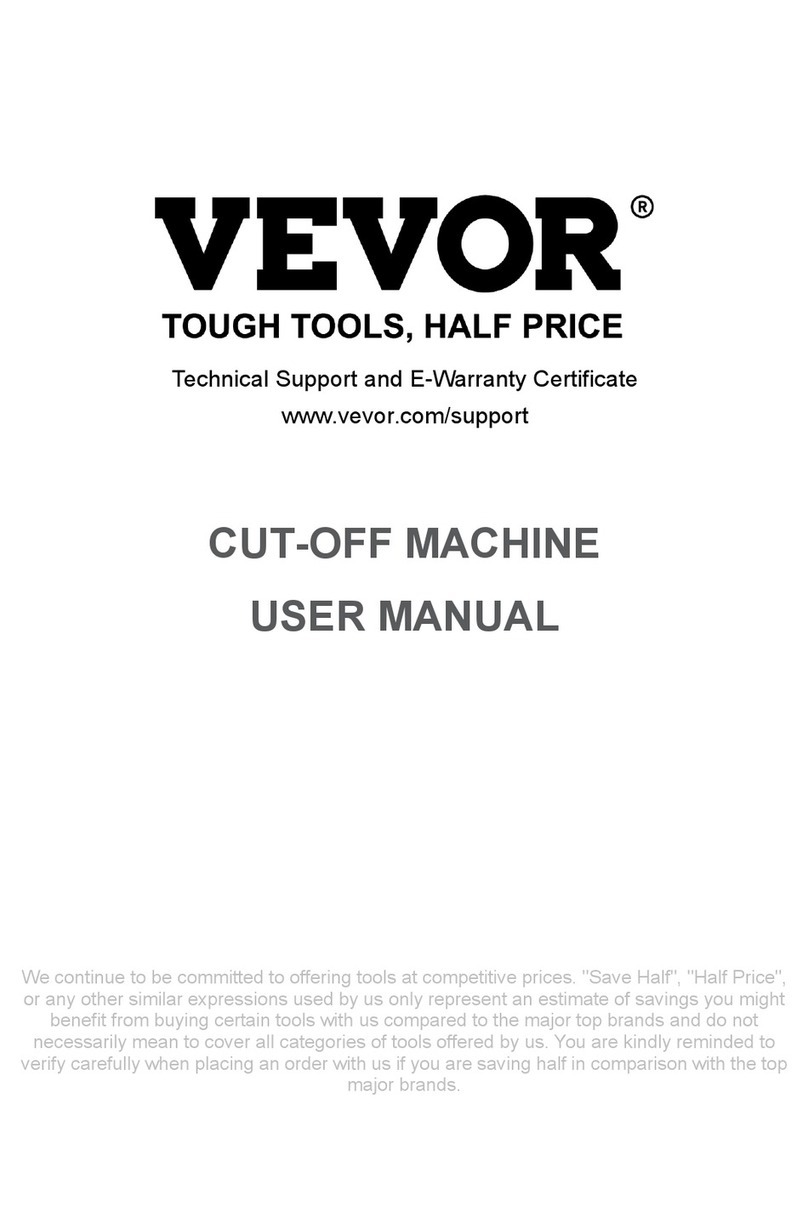
VEVOR
VEVOR J1G-ZB-355G-3 User manual

VEVOR
VEVOR RD03-4001 User manual



